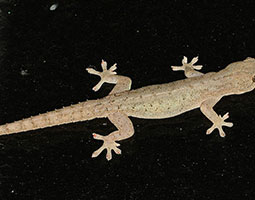Hemidactylus frenatus
Description

The Asian House Gecko (Hemidactylus frenatus) is native to Asia and the Indo-Pacific region. It was accidentally introduced to northern Australia during the 1950's, and they have since spread rapidly, arriving in Brisbane by the early 1980's.
Asian House Geckoes can grow to a length of 11cm and are most commonly encountered around the home, where their distinctive ‘chuck chuck chuck’ call is all too common in the warmer months. Their colour can vary from pale pinkish-brown to dark grey. They are easily distinguished from native species by a series of small spines along the back and edges of the tail.
They can sometimes be heard fighting at night over territory, with individuals making a loud squeaking sound.
Female geckoes lay hard shelled eggs in sheltered places in cracks and walls.
The rapid spread of Asian House Geckos across northern Australia has led to concerns that they may displace local species of geckoes that they compete with for food and shelter.
Adaptations
- Large eyes enable them to see at night, find prey and avoid predators
- Populations tend to thrive where humans are living, attracted to night lights for feeding and houses for shelter
- Eggs resist drying out and are able to survive travel, allowing the species to disperse rapidly via human transport
Feeding relationships
- What I eat: insects and spiders
- What eats me: snakes (e.g. Brown Tree Snake); birds (e.g. Tawny Frogmouth)
Interesting facts
Geckoes do not climb using suction, but rather use 1000's of microscopic pads that allow them to climb almost any surface.